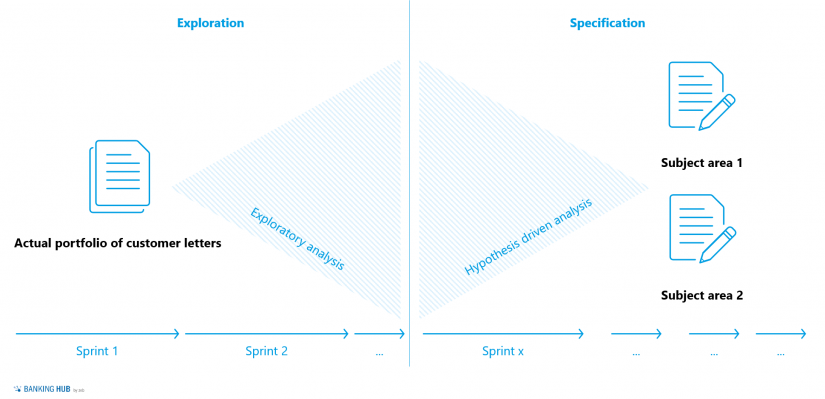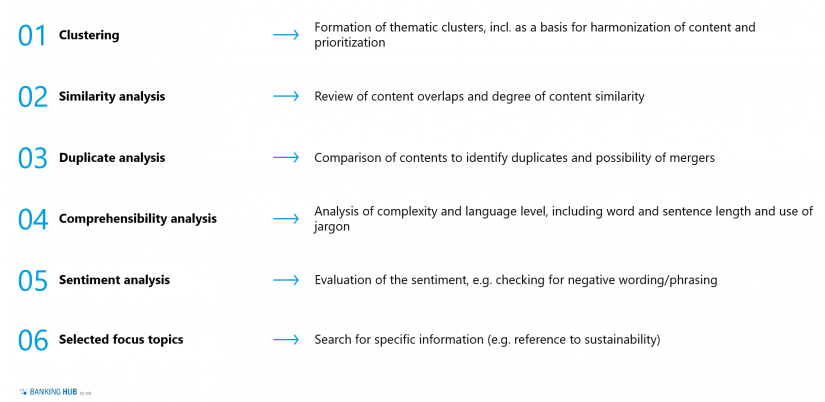Status quo: Lack of online penetration and missing feedback in the customer communication
Interaction with customers is often still paper-based in many banks and insurance companies. The reasons for this are quite varied and span from a lack of online penetration to regulatory requirements as well as explicit customer wishes.
At the same time, the disadvantages of paper-based communication by post are obvious: high printing and postage costs combined with manual efforts in the creating, maintaining and further developing the communication portfolio. In addition, communication by letter is often a one-way street, without feedback and exploitation of a multi-channel offer. But even via digital channels, customer communication often still seems redundant, vague and misleading from the customer’s point of view.
However, our project experience also shows that before it is possible thinking about modern, customer lifecycle-oriented communication with customer-specific content via all available channels, it is first necessary to have transparency about the actual portfolio of the various letters. If you consider that these portfolios have often grown over many years and in practice quickly comprise more than 1,000 different customer letters, the challenge facing the responsible departments becomes clear – not to mention diverse source systems and new regulatory requirements.
BankingHub-Newsletter
Analyses, articles and interviews about trends & innovation in banking delivered right to your inbox every 2-3 weeks
"(Required)" indicates required fields
NLP and AI as solution in the customer approach
With this in mind, AI algorithms lend themselves to first getting a grip on the many documents in a resource-saving way. Natural Language Processing (NLP) can help to quickly gain an overview on today’s portfolio of customer letters and to detect anomalies.
AI-based analyses can be used to identify specific starting points in the portfolio: Where are the content-related overlaps? Where are any possible redundancies? How complex and comprehensible are the individual letters? How can the different letters be grouped in terms of content?
Generally, various analyses with different focuses are conceivable for a holistic view of the actual portfolio. A possible selection is made individually and depending on the objective. Figure 1 shows examples of starting points for reducing variants or merging overlapping letters, resolving redundancies, reducing sentence length and avoiding convoluted sentences. But also choosing shorter words, reducing complexity and including further references can be considered.
Furthermore, algorithms can be used to review the regulatory requirement. The use of unnecessary technical terms and negative formulations can be examined and optimized in the same way as the basic optimization with regard to the address for the respective target channel, e.g. for post or e-mail.
In our projects, we recommend a “sprint” approach with weekly review cycles in order to arrive at usable findings as quickly as possible. Here, we basically distinguish between two successive phases, as Figure 2 shows. As a basis for the subsequent analyses, the documents to be considered are first broken down, simplified or, if necessary, extracted with the help of OCR. In the exploration phase, the analyses listed in Figure 1 are then applied to the existing portfolio and initial findings are derived.
In the subsequent specification phase, the initial findings are built upon and substantiated. Why, for example, are similar facts described differently in different letters? Do the letters always follow the same logic from the customer’s point of view and do they build on each other in terms of content? Which discussion points can be meaningfully linked to further topics and which sales approaches can be generated? With the help of these and other questions, concrete measures can be derived and clarified. The entire process is characterized by a close exchange with the respective specialist department.
How long each individual phase takes depends, among other things, on the volume and complexity of the documents. Experience shows that useful results can already be achieved with 1–2 weeks per phase.
 Figure 2: An iterative sprint approach, where the number of sprints depends on the size of the portfolio and the targeted analyses
Figure 2: An iterative sprint approach, where the number of sprints depends on the size of the portfolio and the targeted analysesAI algorithms to analyze the customer communications portfolio
The use of AI algorithms to analyze the customer communications portfolio impacts two main dimensions: Firstly, efficiency and cost potentials can be realized by optimizing the portfolio. Examples include the reduction of printing and postage costs or the avoidance of manual efforts in the context of editing and administration of the letters. Our project experience shows that up to 25% of the existing portfolio can be eliminated due to redundancies.
Moreover, every adjustment to the communication portfolio has a direct impact on the customer interface and is therefore relevant to sales. A consistent approach and an improvement in comprehensibility positively impact the customer experience.
In a subsequent step, data analytics could be used to target customer groups relating to specific topics and products for which they are particularly receptive. This way, customers would benefit from receiving fewer, but more targeted and understandable letters.
Conclusion on the use of AI in customer communication
Through analysis with NLP, concrete starting points for optimization in customer communication portfolio analysis can be derived, all of which ultimately have an effect on an improved customer experience. At the same time, the sprint approach presented here offers the possibility of producing usable results within a very short time and of transferring these findings to the next sprint. In this way, the analysis forms a good starting point for further optimizations on the way to modern and efficient customer communication.








